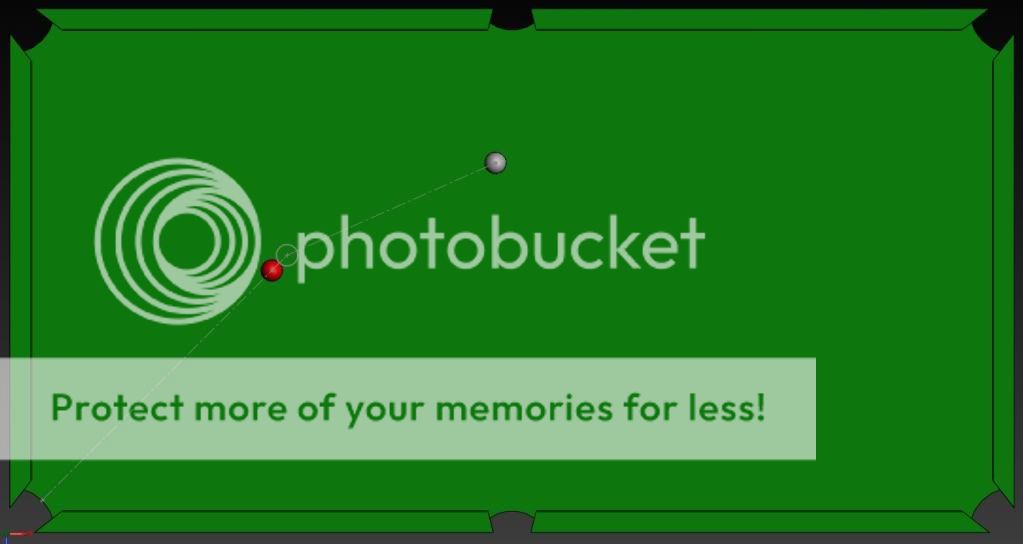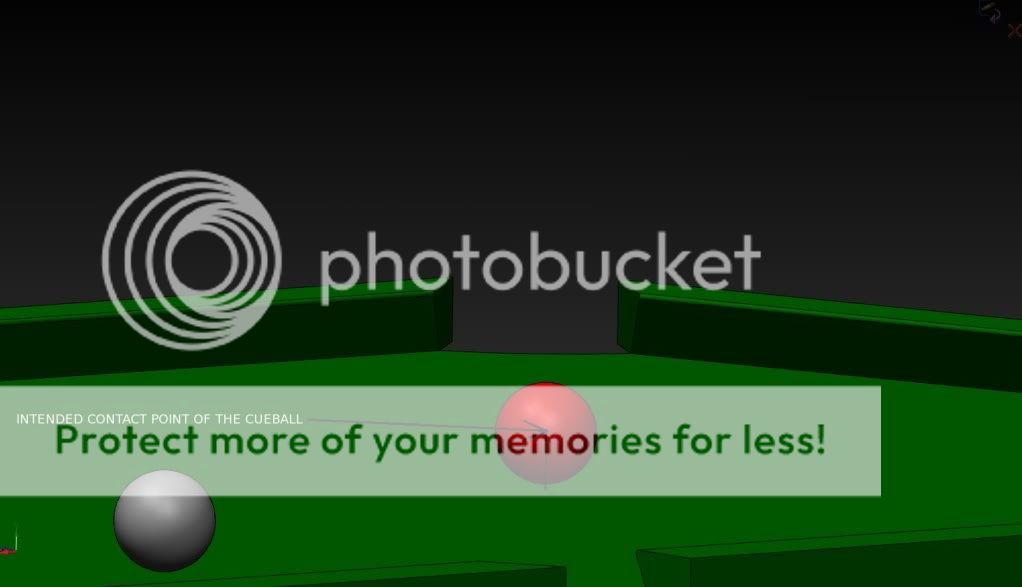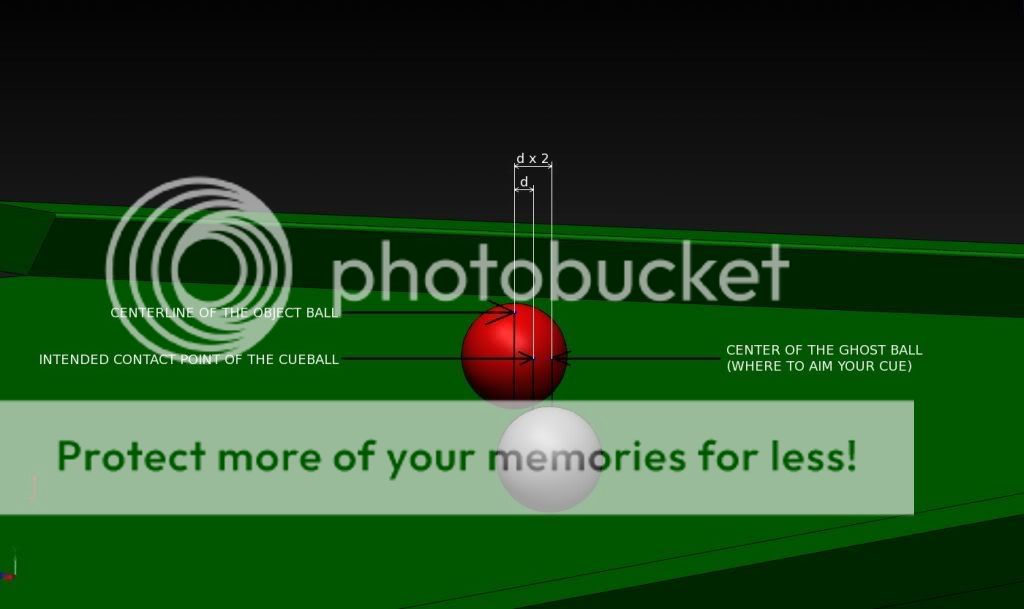Hello everybody,
It's been a little while now that I've joined the AZBilliards community, and I've received many great advices, and even a free DVD from our friend Gene Albrecht. Time for me to give a little back to the community.
I see many methods being mentioned here for properly aiming an object ball: ghost ball, contact point, Gene's fractional aiming method and reflective methods, angle reckoning, etc... But there's one I never see mentioned, which is the one I developed myself years ago when I was a beginner. I thought it was obvious, but then perhaps not, so you may be interested in it. It carried me through my beginner years until I could shoot without it and rely on experience alone.
Since a drawing is worth a thousand words, I whipped out the handy CAD software and quickly modeled a shooting situation.
First of all, the method is a center aiming method, not an edge aiming method. So you'll be wanting to line up your cue's shaft, the center of the cueball and the point it allows you to find on the object ball you want to pocket.
So, suppose you want to shoot the red ball into the pocket in the following situation (I've drawn a traditional ghost ball diagram on the table to make things even clearer):

Now, line up your cue as if you wanted to shoot the red ball directly into the pocket. Aim at the center of the ball, and remember the point on the surface of the ball where your tip would hit if you did shoot it. This is more or less where you want your cueball to hit the red ball. So far, nothing different from the contact point method.

Usually balls aren't completely clean and shiny, or there are features that can help you to remember the contact point (like the edge of a stripe, part of a ball number, some dirt, etc...). If the ball is exceptionally clean and featureless at this spot, you'll have to move to the next step without taking your eyes off it. But don't worry, it doesn't happen that often in reality.
Now, move over to the cueball and go down on your shot. Look at the point you've determined on the object ball, determine mentally the distance between the center of the object ball and that point, then (and that's the clever bit) aim at a second point twice further from the center of the object ball:

That new (and final) point of aim is the center of the ghost ball. For fuller cut shots, it may be inside the "circle" of the object ball, and for thinner cuts, it may be outside. It may also help to mentally correlate it with a feature on the object ball or on the cloth to be able to quickly re-take your aim if you want to interrupt your shot routine and go examine something else on the table
That's it. Easy isn't it?
Of course, for purists, it is geometrically correct, but in reality wrong, because it doesn't take throw into account, but it gets you pretty close to the truth. But then neither the ghost ball nor contact methods give you the true line of aim anyway, and people use them successfully, so my little method will work for you just as well.
Hope it'll help.
It's been a little while now that I've joined the AZBilliards community, and I've received many great advices, and even a free DVD from our friend Gene Albrecht. Time for me to give a little back to the community.
I see many methods being mentioned here for properly aiming an object ball: ghost ball, contact point, Gene's fractional aiming method and reflective methods, angle reckoning, etc... But there's one I never see mentioned, which is the one I developed myself years ago when I was a beginner. I thought it was obvious, but then perhaps not, so you may be interested in it. It carried me through my beginner years until I could shoot without it and rely on experience alone.
Since a drawing is worth a thousand words, I whipped out the handy CAD software and quickly modeled a shooting situation.
First of all, the method is a center aiming method, not an edge aiming method. So you'll be wanting to line up your cue's shaft, the center of the cueball and the point it allows you to find on the object ball you want to pocket.
So, suppose you want to shoot the red ball into the pocket in the following situation (I've drawn a traditional ghost ball diagram on the table to make things even clearer):

Now, line up your cue as if you wanted to shoot the red ball directly into the pocket. Aim at the center of the ball, and remember the point on the surface of the ball where your tip would hit if you did shoot it. This is more or less where you want your cueball to hit the red ball. So far, nothing different from the contact point method.

Usually balls aren't completely clean and shiny, or there are features that can help you to remember the contact point (like the edge of a stripe, part of a ball number, some dirt, etc...). If the ball is exceptionally clean and featureless at this spot, you'll have to move to the next step without taking your eyes off it. But don't worry, it doesn't happen that often in reality.
Now, move over to the cueball and go down on your shot. Look at the point you've determined on the object ball, determine mentally the distance between the center of the object ball and that point, then (and that's the clever bit) aim at a second point twice further from the center of the object ball:

That new (and final) point of aim is the center of the ghost ball. For fuller cut shots, it may be inside the "circle" of the object ball, and for thinner cuts, it may be outside. It may also help to mentally correlate it with a feature on the object ball or on the cloth to be able to quickly re-take your aim if you want to interrupt your shot routine and go examine something else on the table
That's it. Easy isn't it?
Of course, for purists, it is geometrically correct, but in reality wrong, because it doesn't take throw into account, but it gets you pretty close to the truth. But then neither the ghost ball nor contact methods give you the true line of aim anyway, and people use them successfully, so my little method will work for you just as well.
Hope it'll help.